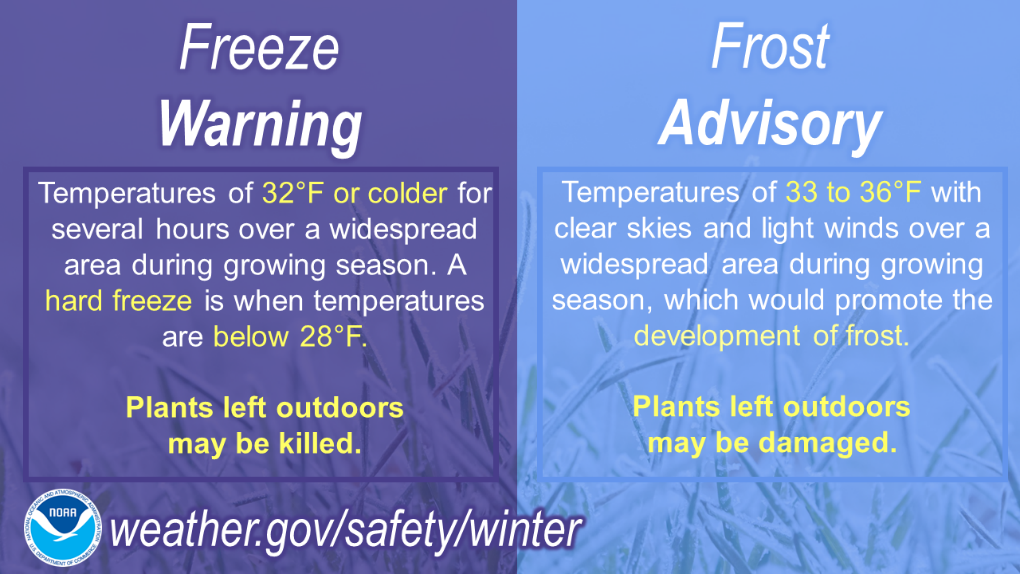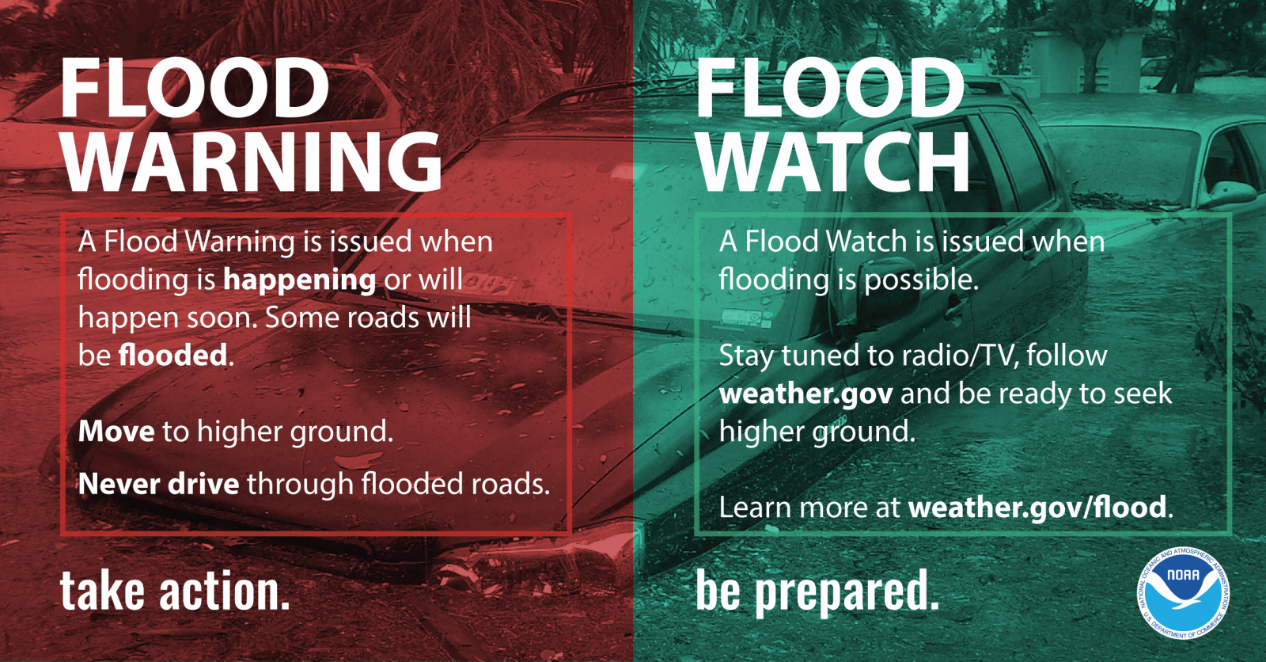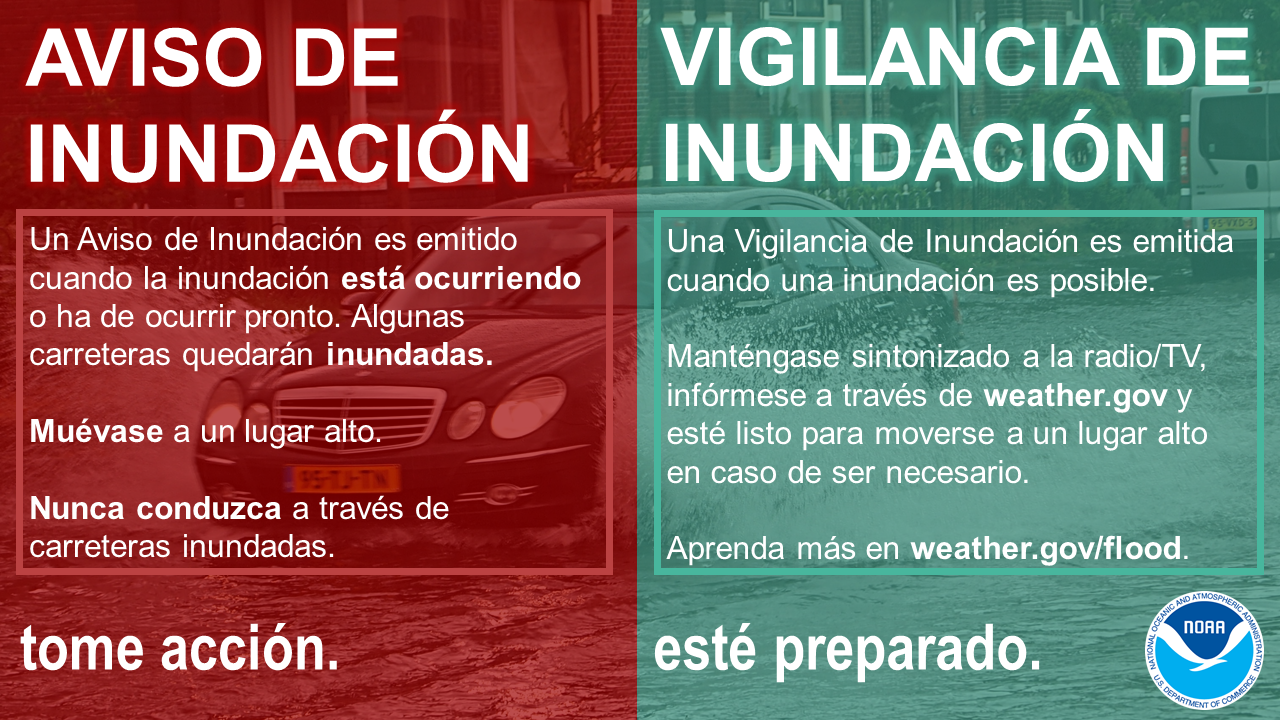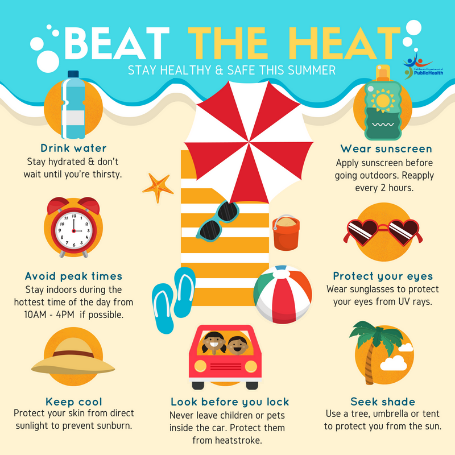Cold Weather Events
Cold events presents different challenges. This link provides helpful tips to prepare and react to dangers of a winter storm.
Weather Alerts
Frost Advisories - These are issued when widespread frost may occur. Frost advisories are not issued after the first freeze event of the winter until spring bloom begins. Although warm-season plants may die with the first frost, there are no frost warnings because frost damage is generally cosmetic to cold season crops.
Freeze Warnings - These are issued for areas with significant commercial agriculture whenever the first freeze of the winter is expected. The first freeze is defined as "when minimum shelter temperature is forecast to be 32 degrees or less during the locally defined growing season."
Flood Warning - a Flood Warning is issued when flooding is happening or will happen soon. Move to higher ground.
Flood Watch - a Flood Watch is issued when there is a potential for a flood. Prepare to evacuate and follow news for more information.
Warming Centers
Warming centers are now open throughout San Joaquin County and offer community members a warm, dry, and safe place to stay during the storm. While most warming centers are open during regular business hours, community members are encouraged to contact the locations listed below for more information on holiday hours of operation. For more information about warming centers, visit the links below or call 2-1-1.
| Name | Address | City | State | Zip | Phone |
|---|---|---|---|---|---|
| Lodi Community Center | 415 South Sacramento Street | Lodi | CA | 95240 | (209) 331-7516 |
| Boggs Tract Center | 533 S. Los Angeles Street | Stockton | CA | 95203 | (209) 468-3978 |
| Northeast Community Center | 2885 E. Harding Way | Stockton | CA | 95205 | (209) 468-3918 |
| Kennedy Community Center | 2800 South D Street | Stockton | CA | 95206 | (209) 468-3986 |
| Garden Acres Community Center | 607 Bird Avenue | Stockton | CA | 95215 | (209) 468-3984 |
| Taft Community Center | 389 W. Downing Ave | Stockton | CA | 95206 | (209) 468-4168 |
| Thornton Community Center | 26675 N. Sacramento Blvd | Thornton | CA | 95686 | (209) 468-1784 |
| Larch Clover Community Center | 11157 West Larch Road | Tracy | CA | 95376 | (209) 831-5920 |
| Tracy Branch Library | 20 E. Eaton Ave | Tracy | CA | 95376 | (866) 805-7323 |
| Lolly Hansen Senior Center | 375 E. 9th Street | Tracy | CA | 95376 | (209) 831-6240 |
| West Valley Mall | 3200 N. Naglee Road | Tracy | CA | 95376 | (209) 836-4091 |
| Transit Station | 50 E. 6th Street | Tracy | CA | 95376 | (209) 831-4287 |
Carbon Monoxide
Carbon Monoxide (CO) is a poisonous, colorless, odorless and tasteless gas. Although it has no detectable odor, CO is often mixed with other gases that do have an odor. You can inhale carbon monoxide right along with gases that you can smell and not even know that CO is present. Carbon monoxide is harmful when breathed because it displaces oxygen in the blood and deprives the heart, brain and other vital organs of oxygen. Large amounts of CO can overcome you in minutes without warning — causing you to lose consciousness and suffocate. Household appliances, such as gas fires, boilers, central heating systems, water heaters, cookers, and open fires that use gas, oil, coal and wood may be possible sources of CO gas. It happens when the fuel does not burn fully.
What can you do if you suspect that someone has been poisoned with CO?
When you suspect CO poisoning, promptly taking the following actions can save lives:
- Move the victim immediately to fresh air in an open area.
- Call 911 or another local emergency number for medical attention or assistance.
- Do not go back inside.
Safety Tips
- Have your home heating systems (including chimneys and vents) inspected and serviced annually by a trained service technician.
- Never use portable generators inside homes or garages, even if doors and windows are open. Use generators outside only, far away from the home.
- Never bring a charcoal grill into the house for heating or cooking. Do not barbeque in the garage.
- Never use a gas range or oven for heating.
- Open the fireplace damper before lighting a fire and keep it open until the ashes are cool. An open damper may help prevent build-up of poisonous gases inside the home.
- Install battery-operated CO alarms or CO alarms with battery backup in your home outside separate sleeping areas.
- Know the symptoms of carbon monoxide poisoning: headache, dizziness, weakness, nausea, vomiting, sleepiness, and confusion. If you suspect CO poisoning, get outside to fresh air immediately, and then call 911.
Extreme weather can lead to heightened healthcare risks, damage to infrastructure and personal property. Extreme weather includes extreme heat, cold, precipitation and wind events. The following links are helpful in gathering current information and resources available during an extreme weather event.
The following link provides weather alerts by location and provides forecasts with possible weather related events. Locations can be searched by city or zip code to get detailed forecasts. Other weather related events such as air quality can be viewed at https://www.weather.gov/.
Drink plenty of fluids, stay in an air-conditioned room, stay out of the sun, and check up on relatives and neighbors. Young children and pets should never be left unattended in vehicles under any circumstances.
Take extra precautions if you work or spend time outside. When possible reschedule strenuous activities to early morning or evening. Know the signs and symptoms of heat exhaustion and heat stroke. Wear lightweight and loose fitting clothing when possible.
Anyone overcome by heat should be moved to a cool and shaded location. Heat stroke is an emergency! Call 9 1 1.
Hot Weather Events
Stay Cool – Find Your Local Cooling Center in San Joaquin County
Cooling locations are free, indoor air-conditioned locations where you can keep cool when there are extreme heat weather conditions. Call 211 for the San Joaquin County Cooling Locations nearest you.
Understanding the Danger of Extreme Heat
Extreme heat is defined as a long period of high heat combined with humidity and temperatures above 90 degrees. In extreme heat, evaporation is slowed and the human body must work extra hard to maintain a normal temperature. Remember that:
- Extreme heat can occur quickly and without warning;
- Older adults, children, and sick or overweight individuals are at greatest risk from extreme heat; and
- Humidity increases the feeling of heat.
The seasons are changing and the temperatures are going up. It's that time of year to once again start considering the effects of warmer temperatures and take appropriate precautions to protect your health and safety.
Each year approximately 20 people die from heat-related emergencies. In 2006 a severe heatwave resulted in 655 deaths and over 16,000 excess emergency room visits throughout the state.
Quick Tip: Organizations that Should Take Extra Precautions during Extreme Heat
Schools, day camps and non-school related sports organizations or athletes should take extra precaution when there is extreme heat. Sports practice and other outdoor activities should be scheduled early or very late in the day in order to limit the amount of time spent in the sun and heat.
Staying Safe: Before Extreme Heat
Prepare for extreme heat by doing the following:
- See current Watches, Warnings or Advisories from the National Weather Service.
- Find places in your nearby where you can go get cool. San Joaquin County Cooling Centers & Zones
- Keep your home cool by covering windows with drapes/shades, add insulation to keep the heat out, use attic fans to clear hot air, and install window air conditioners and insulate around them.
- Power outages may occur when there is extreme heat. Click on this link to review safety tips for power outages.
Staying Safe: During Extreme Heat

stay indoors from 10 a.m. to 3 p.m. when the burning rays are strongest.

drink 2 to 4 glasses of water every hour during times of extreme heat.


reduce physical activity and avoid exercising outdoors during peak heat hours.

wear a wide-brimmed hat and light-colored lightweight, loose-fitting clothes when you are outdoors.

with a sun protection factor of at least 15 if you need to be in the sun.

set your air conditioner between 75° to 80°. If you don’t have air conditioning, take a cool shower twice a day and visit a public air conditioned facility.

heat also affects your pets, keep them indoors or if they will be outside, make sure they have plenty of water and a shaded area to help them keep cool.

sweating removes salt and minerals from your body, so replenish these nutrients with low sugar fruit juices or sports drinks during exercise or when working outside.

check on elderly neighbors and family and friends who do not have air conditioning. Infants and children up to 4 years old, people who overexert during work or exercise (e.g. construction workers) and people 65 years and older are at the highest risk of heat-related illnesses.
Never leave a pet alone in a vehicle, even with the windows cracked or open. Pets should not be left in a garage, since garages can get very hot due to lack of ventilation and insulation. Click here to download pet safety tips.
Tips for Specific Groups
To better understand how to beat the heat and stay cool in extreme weather, please take a look at the information that the CDC has for those especially vulnerable to heat exhaustion and stroke.
Find answers to questions about the power grid and the role the California ISO performs as the impartial link between power plants and the utilities that provide electricity to 30 million Californians.




